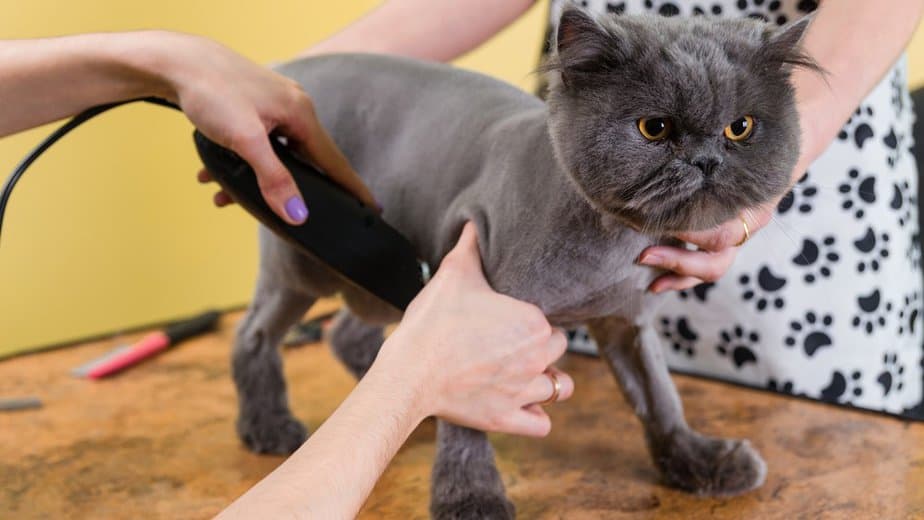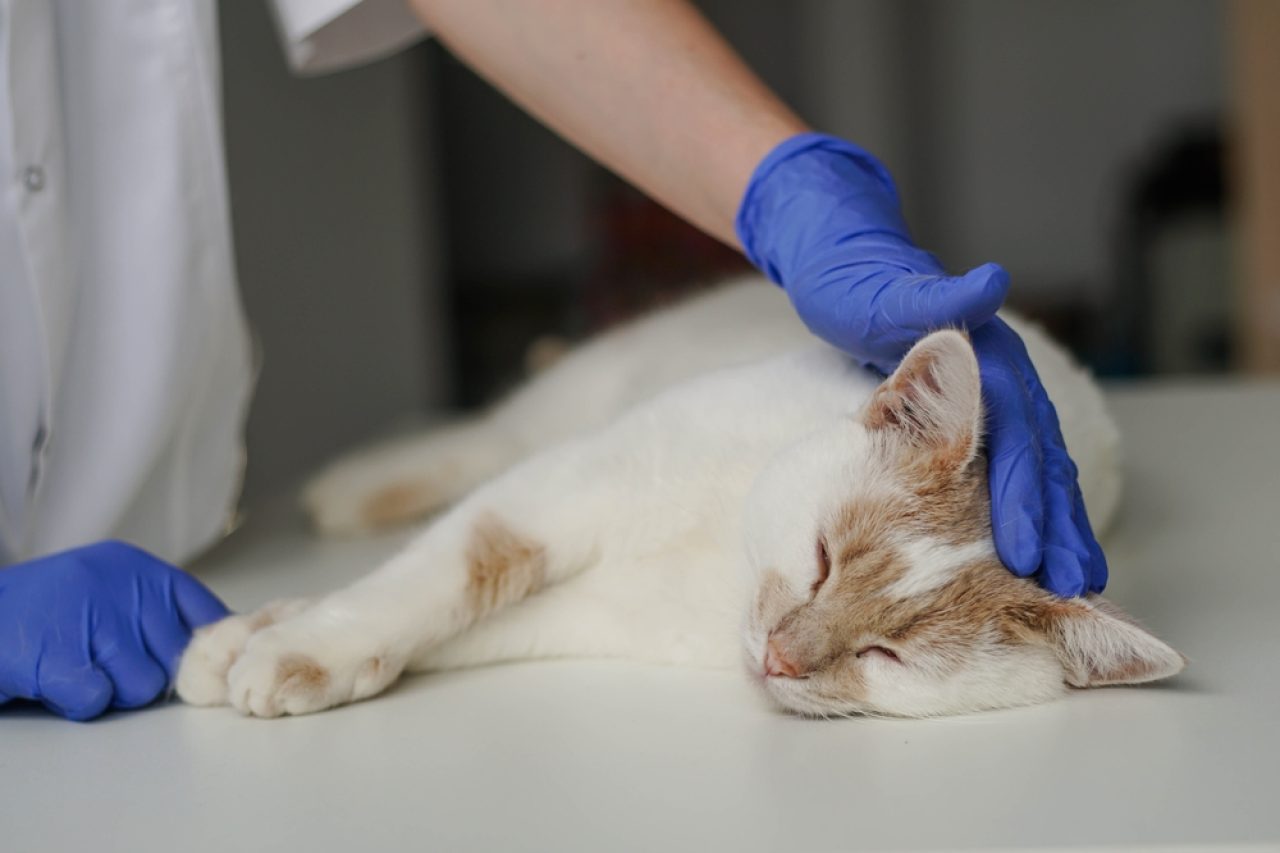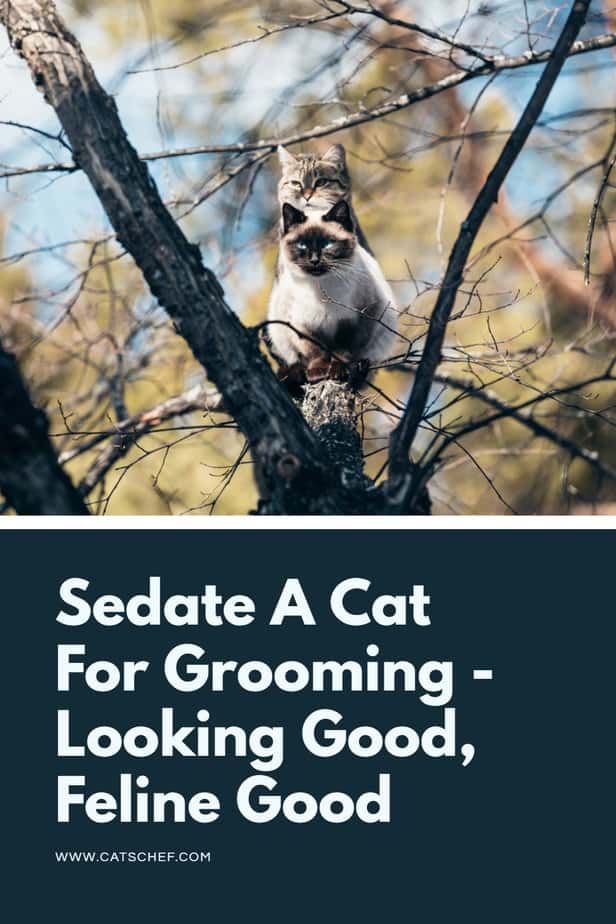📖 Table of Content:
Every cat parent is familiar with delaying grooming for as long as possible. Sometimes it takes days of mental preparation just to make your feline all nice and pretty. The whole process can seem like a scene from an action movie, and it gets you thinking if there’s any way to sedate a cat for grooming.
You’re not a bad cat parent for feeling this way. Feline grooming really is a challenge. They like their peace and privacy and only want to be touched when and how they want. Real queen behavior that we’ve all come to terms with.
Cats have routines they’re really protective of and want no human intervention with those. But grooming is an important part of keeping your feline healthy, especially if she’s one of the long-haired breeds. Sometimes, you have to do what’s best for her, no matter how much she hates it.
If grooming your cat is almost an impossible task, then it’s better to find out if you can sedate her. You simply don’t have time to spend on her whining and complaining, so it is worth a shot. It could be a much easier and less stressful process for both of you. Who knows – maybe your cat ends up liking it.
If you have your worries and questions regarding sedation, it’s perfectly normal – and it’s good that you do. It means you’re a conscious cat parent who wants to make sure her kitty is safe. Well, you’ve come to the right place. We’ll spill all the tea we have on sedating your cat for grooming, so let’s dive right in.
Is it safe to sedate a cat for grooming?
When you think of sedating your cat, the first question that probably pops up in your mind is, “How safe is it?”. Well, since there are many ways you can sedate your cat for grooming you can choose the safest option.
Don’t get me wrong, everything we list is safe, but some methods need more attention than others. If you opt for a more natural way to sedate a cat for grooming, it’s something you can do on your own because there’s not much that can go wrong with it.
However, if your feline requires more than just calming scents and warm towels, it’s best to consult her vet. You should never give your kitty medication without taking advice from a professional, especially sedatives.
With appropriate precautions and dosing plans, sedating your cat is fairly safe. Much safer than exposing her to unbearable stress that can leave her feeling scared and anxious. Before prescribing any medications, the veterinarian will check her heart, kidney, and liver. That way, your lovely furbaby will be perfectly safe.
Signs that your feline needs sedation
Not every cat requires sedation just to stay clean and healthy. If you’re one of the lucky cat parents, your feline enjoys grooming. In that case, tell us what’s it like to live in a fairyland.
But, since you’re here, your experience is probably nothing of the sort, and there’s a high chance you’re desperate for a solution. Everyone knows cats hate when someone invades their personal space. If you add trimming their nails to it, it can quickly turn into a war zone.
Although most cats don’t enjoy it, some felines get more anxious and stressed than others. If your kitty is one of the overly anxious ones, you might notice these changes:
- Her eyes getting wider and her pupils dilated
- Excessive and loud meowing
- Head shaking and body twitching
- Flattened ears
- Biting
If any of these things happen, sedating your cat is probably a good idea. Too much stress and anxiety can have long-term effects on her health, so it’s best to avoid it.
6 tips and tricks to sedate your cat for grooming
Now that we’ve learned that sedating your feline is perfectly safe if done right, it’s time to learn about many methods you can use. Before you consult a vet and opt for medication, we advise you to try some of the more natural ways to keep your kitty calm.
Sedation isn’t only helpful in keeping your kitty serene, but it can also help the groomer in this challenging task. Here are the best methods to sedate a cat for grooming and keep the whole process painless for everyone.
1. Body or towel wraps for a full spa experience
If there’s one thing cats love, it’s blankets. Our furbabies love feeling warm and comfy, and it provides them with a sense of safety and protection. Because of this feeling of security, wrapping your kitty in a warm blanket or a towel can help you groom her without unnecessary fighting.
So, all you need for this method is a soft and warm towel and a bit of patience. Wrap your fluff like a burrito, give her some love, and get to grooming and cutting her nails. Maybe even take some pictures, your little purrito will be incredibly hard to resist.
Not only is it cute and something she’ll probably enjoy, but it’s also a great way to naturally sedate your cat for grooming. This approach reduces stress by applying a small amount of pressure on your kitty’s chest, making her feel safe. It’s like a warm hug we all need.
2. Cat calming treats for a happy kitty
A delicious treat as a way to sedate a cat for grooming? Sounds purrfect! Calming treats are an amazing way to help your feline unwind. Not only are they efficient, but they’re perfectly safe, too. What else does a cat parent need?
Calming treats are made of different herb blends that decrease stress and help cats feel relaxed. They usually contain valerian, catnip, passionflower, and chamomile – everything that our furballs love. Before choosing the right brand for your kitty, make sure it uses the mix of herbs she enjoys the most.
The pros of using cat calming treats are that they’re safe, readily available, require the least effort, and have very few side effects. They don’t take more than half an hour to work and can keep your feline relaxed for hours. We see no cons to this one – and it’s all-natural.
3. Pheromone diffusers for a bit of zen
To communicate with other cats in their surroundings, felines release chemicals called pheromones. They help them feel relaxed and greatly contribute to keeping their stress levels low. What if there was a way to use this gift of nature to sedate your cat for grooming? We’re happy to inform you that there is.
Luckily for us, some smart people came up with the idea of creating synthetic pheromone diffusers. They are a nice and natural way to keep your cat relaxed before and during grooming. However, before opting for this method, make sure you arm yourself with patience.
Pheromone diffusers take a bit longer to work on felines than cat-calming treats. On top of that, your fur friend needs to be within a certain range of the diffuser to start feeling its effect. If that doesn’t sound appealing, try wipes and sprays that are infused with these chemicals. They might be more efficient.
4. Fancy calming collars
Working in the same way as pheromone diffusers, calming collars are a great way to deal with your fluff’s anxiety. They might even be more efficient than our previous method because they release the chemicals around your cat’s head, making it easier for her to inhale them.
Keeping your cat in one place is almost an impossible task. If your purrincess wants to move – she’ll move. If you try to keep her in one place just to get some of that sweet pheromone from your diffuser, she might meow your roof off.
In case your kitty has trouble staying in one room, then a calming collar might be a perfect solution for you to sedate your cat for grooming. The collars can greatly contribute to your feline feeling secure and calm – and they’ll make her look fancy.
Don’t worry, the dose is just enough to help reduce your furbaby’s anxiety and stress and regulate her mood. If your cat is anxious often, getting this collar might be a good option for you, not only for grooming.
Just make sure you choose the right one for her size so that it sits comfortably around her neck.
5. Medication
If none of the natural methods work, you might have more on your plate than we’ve thought. Sometimes, natural methods are simply not enough, and that’s completely fine. It’s important to help your feline friend stay relaxed, even if it takes a few visits to the vet.
However, if you opt for medicated methods, it’s essential to be extra careful about what it is that you’re giving to your kitty. You should never give your cat medication without consulting her vet. Although medication is a quick and efficient way to keep your feline calm, there can be some side effects.
To avoid them, your vet will run all the necessary tests to make sure your kitty is getting the right prescription. Don’t worry, they’ll tell you the right medication to give your fluff and the perfect dosage for her. So, you really can’t go wrong here. You just have to listen to professional advice and stick to it strictly.
No, you’re not doing anything wrong by sedating your cat. It’s arguably the most humane way you can groom your feline. She’ll avoid all the unnecessary stress grooming brings her, so you’re doing your furbaby a favor.
Some drugs often given to help sedate our cats for grooming are Acepromazine and Benadryl. Out of the two, Acepromazine is the safer option because it has minimal side effects and is suitable for most cats that don’t have liver, heart, or kidney issues. But you must follow the vet’s instructions with both.
Other common meds include Trazodone, Gabapentin, and Alprazolam. Because they’re so delicate to deal with, your cat’s veterinarian will prescribe the perfect dose. It will be just enough for your fluff to decompress.
Since all of them can have some side effects, you must keep a close eye on your feline and her reaction to these drugs.
6. General anesthesia for extreme cases
In extreme cases, general anesthesia is the best possible solution to sedate a cat for grooming.
If you’ve rescued a stray cat who’s already in a lot of distress and requires urgent grooming, general anesthesia could be her life-saver. Parasites, extremely matted fur, and infected injuries are all genuine reasons to go for this method.
Of course, unless some of us are vets, we can’t put our cats under general anesthesia on our own. This method is only reserved for professionals and vet stations that have the proper equipment. It can be done through injection or gas inhalation, and it should always be performed by a licensed veterinarian.
Possible side effects of sedating your feline
Taking sedative drugs can cause some side effects, which is why it’s so important that they’re prescribed by a vet. Although most of them could disappear within 24 hours, some of the effects could indicate that your kitty has some underlying issues that you weren’t aware of.
Sometimes, if not prescribed properly, sedatives can have the opposite effect of what we were hoping to achieve. It’s not uncommon for cats to start acting more aggressive and irritated if their bodies don’t react to sedative medication properly.
On top of that, it’s important to let the vet know of any other medication that your cat might be using. Sedatives can have dangerous interactions with other meds, which could further complicate any medical issues that your kitty already has.
Common side effects of using sedatives in cats include:
- Nausea, vomiting, and diarrhea
- A change in appetite
- Low blood pressure
- Aggression and irritability
If possible, it’s best that your vet monitors your sedated cat. That way, they can treat her if there are any irregularities in her behavior and reaction. If that’s not possible, ask the vet for advice on what you can do to prepare your cat for sedatives, and what should be your approach if anything goes wrong.
How to choose the right sedation method for your feline
Choosing the right method of sedation for your cat could help you avoid all the unnecessary side effects. For example, if your kitty simply doesn’t like grooming and her reaction to it is to meow and complain – that’s not too serious.
Most cats don’t like us passing our routines onto them when they have their own, especially if they involve water. Meowing and whining are perfectly normal reactions, so using a natural method to calm her down might be the best option for you.
A good thing to think about is what type of grooming you’re planning to do. If it’s simply clipping her nails, a nice warm body wrap should do the trick and there should be no reason for you to use medication.
If your cat is generally stressed and anxious, and she doesn’t respond well to your grooming sessions, you might want to opt for a more serious method. Especially if you suspect that it might leave some negative long-term effects on her mental health.
If you don’t plan on spending too much time on grooming, there’s really no need for you to opt for medication methods unless it’s absolutely necessary. A natural method like a calming treat should be enough for a quick ear cleaning and nail clipping session.
On the other hand, for a full-on hair trimming session, especially on a nervous cat… It’s best to consult a veterinarian. That way, you’ll use the most appropriate method that your cat can have, and you’ll know you’re not doing any harm to her.






